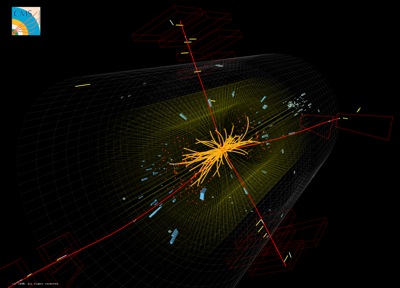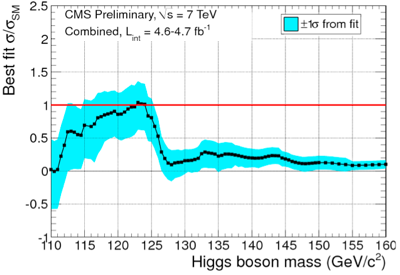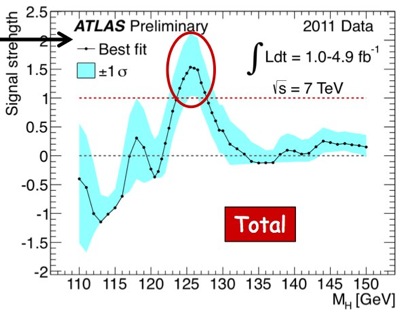Report from the Trenches: A CMS Grad Student's Take on the Higgs
 Hi folks. It's been an embarrassingly long time since I last posted, but
today's news on the Higgs boson has brought me out of hiding. I want to
share my thoughts on today's announcement from the CMS and ATLAS
collaborations on their searches for the Higgs boson. I'm a member of
the CMS collaboration, but these are my views and don't represent those
of the collaboration. The upshot is that ATLAS sees a 2.3 sigma signal
for a Higgs boson at 126 GeV. CMS sees a 1.9 sigma excess around 124
GeV. CERN is being wishy-washy about whether or not this is actually a
discovery. After all the media hype leading up to the announcement, this
is somewhat disappointing, but maybe not too surprising. First of all,
what does a 2 sigma signal mean? The significance corresponds to the
probability of seeing a signal as large or larger than the observed one
given only background events. That is, what's the chance of seeing what
we saw if there is no Higgs boson? You can think of the significance in
terms of a Normal distribution. The probability of the observation
corresponds to the integral of the tails of the Normal distribution from
the significance to infinity. For those of you in the know, this is just
1 minus the CDF evaluated at the significance. For a 2 sigma
observation, this corresponds to about 5%. For both experiments, there
was a 5% chance of observing the signal they observed or bigger if the
Higgs boson doesn't exist. In medicine, this would be considered an
unqualified success. So why is CERN being so cagey? In particle physics
we require at least 3 sigma before we even consider something
interesting, and 5 sigma to consider it an unambiguous discovery. The
reasons why the burden of proof is so much higher in particle physics
than in other fields aren't entirely clear to me. I suspect is has to do
with the relative ease of running the collider a little longer compared
to recruiting more human test subjects, to use medicine as an example.
Given what I've just told you that we need a 3 sigma significance in
particle physics, why is everyone so excited about a couple of 2 sigma
results? Well, the first reason is that both results show bumps at
approximately the same Higgs mass. Although it's not rigorous, you can
get a rough idea of what the significance of the combined results are by
adding the significances in quadrature. This gives us about 2.8 sigma.
Higher, but still not up to the magic number of 3. The explanation for
the excitement that is most compelling brings us to Bayesian statistics.
The paradigm of Bayesian statistics says that our belief in something
given new information is the product of our prior beliefs and a term
which updates them based on the new information. Physicists have long
expected to find a Higgs boson with a mass around 120 GeV. So our prior
degree of belief is pretty high. Thus, it doesn't take as much to
convince us (or me anyway) that we have observed the Higgs boson. In
contrast, consider the OPERA collaboration's measurement of neutrinos
going faster than the speed of light. This claims to be a 6 sigma
result, but no one expected to find superluminal neutrinos, so our (or
at least my) prior for this is much lower. (Aside: If the OPERA result
is wrong, it is likely due to a systematic effect rather than a
statistical one. Nevertheless, I stand by my point.) The final thing
that excites me about this observation is that what we've seen is
completely consistent with what we would expect to see from the Standard
Model. Forgetting about significances for the moment, when the CMS
experiment fits for the Higgs boson mass, they find a cross section that
agrees very well with that predicted by the Standard Model. In the plot
below, you're interested in the masses where the black line is near 1.
The ATLAS experiment actually sees more signal than one would expect.
This is likely just a statistical fluctuation, and explains why the
ATLAS result has a higher significance.
Hi folks. It's been an embarrassingly long time since I last posted, but
today's news on the Higgs boson has brought me out of hiding. I want to
share my thoughts on today's announcement from the CMS and ATLAS
collaborations on their searches for the Higgs boson. I'm a member of
the CMS collaboration, but these are my views and don't represent those
of the collaboration. The upshot is that ATLAS sees a 2.3 sigma signal
for a Higgs boson at 126 GeV. CMS sees a 1.9 sigma excess around 124
GeV. CERN is being wishy-washy about whether or not this is actually a
discovery. After all the media hype leading up to the announcement, this
is somewhat disappointing, but maybe not too surprising. First of all,
what does a 2 sigma signal mean? The significance corresponds to the
probability of seeing a signal as large or larger than the observed one
given only background events. That is, what's the chance of seeing what
we saw if there is no Higgs boson? You can think of the significance in
terms of a Normal distribution. The probability of the observation
corresponds to the integral of the tails of the Normal distribution from
the significance to infinity. For those of you in the know, this is just
1 minus the CDF evaluated at the significance. For a 2 sigma
observation, this corresponds to about 5%. For both experiments, there
was a 5% chance of observing the signal they observed or bigger if the
Higgs boson doesn't exist. In medicine, this would be considered an
unqualified success. So why is CERN being so cagey? In particle physics
we require at least 3 sigma before we even consider something
interesting, and 5 sigma to consider it an unambiguous discovery. The
reasons why the burden of proof is so much higher in particle physics
than in other fields aren't entirely clear to me. I suspect is has to do
with the relative ease of running the collider a little longer compared
to recruiting more human test subjects, to use medicine as an example.
Given what I've just told you that we need a 3 sigma significance in
particle physics, why is everyone so excited about a couple of 2 sigma
results? Well, the first reason is that both results show bumps at
approximately the same Higgs mass. Although it's not rigorous, you can
get a rough idea of what the significance of the combined results are by
adding the significances in quadrature. This gives us about 2.8 sigma.
Higher, but still not up to the magic number of 3. The explanation for
the excitement that is most compelling brings us to Bayesian statistics.
The paradigm of Bayesian statistics says that our belief in something
given new information is the product of our prior beliefs and a term
which updates them based on the new information. Physicists have long
expected to find a Higgs boson with a mass around 120 GeV. So our prior
degree of belief is pretty high. Thus, it doesn't take as much to
convince us (or me anyway) that we have observed the Higgs boson. In
contrast, consider the OPERA collaboration's measurement of neutrinos
going faster than the speed of light. This claims to be a 6 sigma
result, but no one expected to find superluminal neutrinos, so our (or
at least my) prior for this is much lower. (Aside: If the OPERA result
is wrong, it is likely due to a systematic effect rather than a
statistical one. Nevertheless, I stand by my point.) The final thing
that excites me about this observation is that what we've seen is
completely consistent with what we would expect to see from the Standard
Model. Forgetting about significances for the moment, when the CMS
experiment fits for the Higgs boson mass, they find a cross section that
agrees very well with that predicted by the Standard Model. In the plot
below, you're interested in the masses where the black line is near 1.
The ATLAS experiment actually sees more signal than one would expect.
This is likely just a statistical fluctuation, and explains why the
ATLAS result has a higher significance. 
 In conclusion, while CERN is being non-committal, in my opinion, we have
seen the first hints of the Higgs boson. This is mostly due to my high
personal prior that there the Higgs boson exists around the observed
mass. Unfortunately, Bayesian priors are for the most part a qualitative
thing. Thus, ATLAS and CMS are sticking to the hard numbers, which say
that what we have looks promising, but is not yet anything to get
excited about. I'll close by reminding you all to take this all with a
grain of salt. There is every possibility that this is just a
fluctuation. I'll remind you that at the end of last summer, CMS and
ATLAS both showed a 3 sigma
excess
around 140 GeV, which went away just a month later at the next
conference. So let's cross our fingers that next year's data will give
us a definitive answer on this question. By the way, if anyone wants to
know more, fire away in the comments. I'll do my best.
In conclusion, while CERN is being non-committal, in my opinion, we have
seen the first hints of the Higgs boson. This is mostly due to my high
personal prior that there the Higgs boson exists around the observed
mass. Unfortunately, Bayesian priors are for the most part a qualitative
thing. Thus, ATLAS and CMS are sticking to the hard numbers, which say
that what we have looks promising, but is not yet anything to get
excited about. I'll close by reminding you all to take this all with a
grain of salt. There is every possibility that this is just a
fluctuation. I'll remind you that at the end of last summer, CMS and
ATLAS both showed a 3 sigma
excess
around 140 GeV, which went away just a month later at the next
conference. So let's cross our fingers that next year's data will give
us a definitive answer on this question. By the way, if anyone wants to
know more, fire away in the comments. I'll do my best.
Comments
Comments powered by Disqus